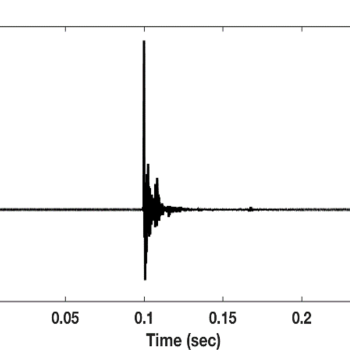Methods and Apparatus for Recording Impulsive Sounds

Noise-induced hearing loss (NIHL) is a significant concern, particularly in hostile or rugged environments. Occupations such as military service or construction often expose individuals to loud impulsive sounds that can lead to NIHL. There is a pressing need for mechanisms that can help in the study and prevention of such hearing damage. However, predicting and preventing NIHL caused by impulsive sounds has been a task limited by inadequate current models. Existing models fail to accurately explain how impulsive sounds can cause NIHL, making it difficult to frame relevant prevention measures. Most models struggle with capturing the characteristics of these sounds because of their fast rise times. Consequently, there's a lack of reliable, high-fidelity data on impulsive noises, impeding comprehensive study and preventive strategies for NIHL.
Technology Description
This technological invention is a compact, portable system that can record, digitize, and store high-bandwidth audio data. The system is aimed at effectively capturing sounds with fast rise times, such as gunfire, jack hammering, and explosions. The recorded audio data has a bandwidth of 20 kHz or higher, and the data acquisition is comprehensive enough to capture sounds with rise times less than 50 ms. An analog-to-digital converter (ADC) digitizes the broadband audio signals at a rate of 40 kHz or higher, preserving the impulse information. Following this conversion, a processor transfers the digitized samples from a buffer to a memory card for future retrieval, utilizing an interrupt-driven processing technique. This technology is instrumental in studying noise-induced hearing loss (NIHL). Its key differentiator is the unique ability to accurately record impulsive sounds that traditional models fail to account for when determining causes of NIHL. By collecting high-fidelity recordings of such sounds, it enables credible and realistic data analysis to better understand, predict, and mitigate NIHL.
Benefits
- Provides reliable, high-fidelity recording of impulsive sounds
- Digitizes and stores data for future retrieval and analysis
- Enhances the understanding, prediction, and mitigation of NIHL
- Allows on-field data capture because of its portability
- Helps inform effective measures for hearing protection
Potential Use Cases
- Military training to preemptively protect soldiers from NIHL
- Gunfire testing facilities to monitor sound levels
- Construction industry to inform workers of the noise produced at construction sites
- Acoustic research studies
- Manufacturing industries to monitor worker exposure to impulsive sounds